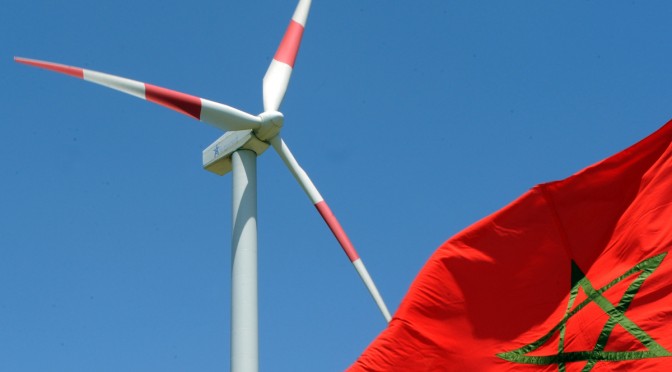Nareva, an energy subsidiary of the Moroccan National Investment Company (SNI), operates four wind farms with a capacity of over 500 megawatt (MW).
Tarfaya wind farm, the newest, is the largest wind energy in Africa.
After starting production of wind energy in 2013 at three of the four farms operated by Nareva, the SNI’s energy subsidiary is finally ready to put Tarfaya farm into service in 2014. All in all, it took six years for the wind turbines, erected by Nareva, to be fully operational. Created in 2005, the holding currently prides itself on its first-of-its-kind achievement realized within the scope of Renewable Energies Law 13-09. It liberalized the production and marketing of electricity from renewable resources through its subsidiary, Moroccan Wind Energy (Energie Eolienne du Maroc, EEM).
This project led to the production of 203 MW, distributed over three production sites: Haouma in the Tangier region, Akhfennir in the Tarfaya region and Foum El Oued in Laayoune.
The three EEM farms have an energy yield of 770 GW/h per year, which is equivalent to the consumption of a city like Agadir. EEM supplies six large companies: Lafarge Maroc, Sonadid, OCP, Managem, Samir and Air Liquide Maroc.
The savings of this project are equivalent to $140 million worth of imported oil per year and represent 10% of the national target to produce 2,000 MW of wind energy by 2020. EEM has allocated an investment budget of 3 billion dirhams [$365.8 million] for the development of the three farms. “Contrary to what some may think, investing in energy is risky. Whether in terms of construction, maintenance or even yield, we draw the hypotheses on the costs required by the project that we then submit to banks for financing. Any additional cost in the project will be immediately supported by the investor,” said Ahmed Nakkuoch, CEO of Nareva Holding. Moreover, the investment payback period, which is theoretically 10 years, may extend if the project is not completed within the time frame fixed in advance or if additional costs are incurred.
Tarfaya, Nareva Holding’s pride
While the EEM project was implemented in the framework of Law 13-09, Tarfaya Energy Company (Tarec), another subsidiary of Nareva, was created through a public-private partnership with the National Electricity and Drinking Water Authority (ONEE) following an international call for tenders. Tarec is jointly owned by Nareva Holding (50%) and GDF Suez (50%). With an installed capacity of 301.3 MW, Tarfaya is the largest wind farm in Africa. It required an investment budget of 5 billion dirhams [$609 million] and generates 1,084 GW/h of energy per year, which is equivalent to the consumption of a city like Marrakech. This power is supplied exclusively to ONEE under a 20-year power purchase agreement. The savings realized by the project are equivalent to $200 million of imported oil per year. Tarfaya’s wind farm contributes by up to 15% in the national target of generating 2,000 MW of wind energy by 2020.
The best is yet to come
Although it has a total wind energy portfolio of over 500 MW, the holding company does not intend to stop here. In partnership with Taqa and Enel Green Power, Nareva was pre-qualified for the 850 MW wind project. As a reminder, last February, ONEE delivered specifications for the tender of the 850MW wind project to the five contract bidding groups, including the consortium led by Nareva. This program represents the second phase of the integrated wind energy program. The 850 MW wind project actually consists of five sites: Midelt (150 MW), Tiskrad (300 MW), Tanger II (100 MW), Jbel Lahdid (200 MW) and Boujdour (100 MW), and should be implemented between 2016 and 2020. “We will submit our offers between June and August,” said Nareva Holding Strategy and Development Director Adel Khamis. To be awarded with the contracts of this large market, the establishment of alliances was necessary. Given the big size of the project, the bidders are required to organize themselves in consortia. A single company will not be able to apply all the measures required for this project, from development, design, financing, to construction, operation and maintenance.
Hence, a partnership between the subsidiary company of SNI, the United Arab Emirates’ Taqa company and Italy’s Enel Green Power has emerged. “The wind industry in Morocco is still very young. The goal of the 850 MW project tender that was issued by ONEE is to push international turbine suppliers to invest in Morocco,” Nakkouch said. The industrial integration of wind energy has not been able to keep pace so far, for various reasons including structural reasons related to the ability of national SMEs-SMIs to fulfill the need for equipment with high technical value. The Moroccan companies operating in the field of renewable energy still have a long way to go in terms of technology, research and development.
In addition, Nareva confirmed that 40% of the works realized in the civil engineering sector (Somagec and SGTM) and the electric network sector (Cegelec) were entrusted to national enterprises. Delattre Levivier Maroc (DLM) was tasked with the building of the wind towers, while logistics were relegated to Alstom Maroc, Siemens Maroc, AGTT and Eurogrue Maroc. “The transfer of technologies in Morocco can only be done through partnerships with foreign operators. According to some talks, ONEE proposed a bid of 1,500 MW. We are hoping that this will be enough for turbine suppliers to install their factories in Morocco,” Nakkouch said. This hazardous industry will be facing many challenges.


